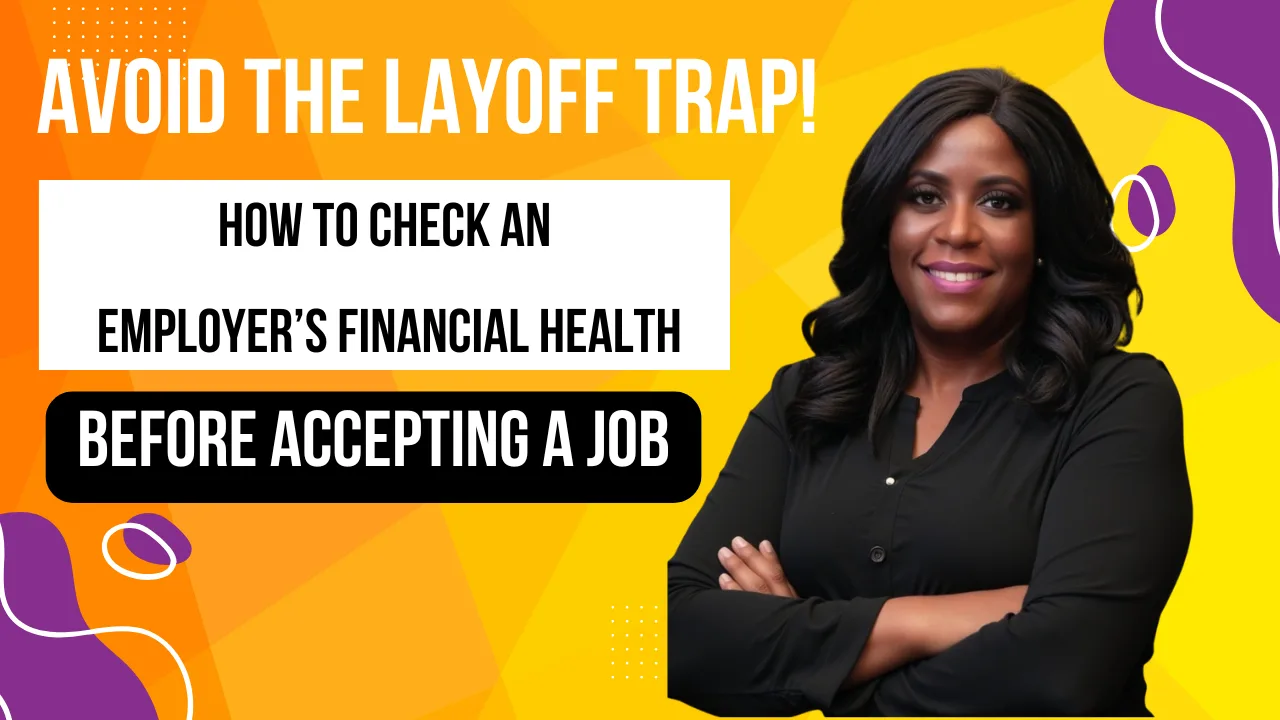March 10, 2025


Landing a new job offer can be exciting, but before signing that contract, there’s a critical question to ask: Is this company’s financial health strong enough to support your career stability?
You don’t want to accept a dream role, only to find out a few months later that your employer’s financial health has resulted in downsizing, delaying paychecks, or even filing for bankruptcy. It’s painful to be laid off two times in a row!
Unfortunately, these scenarios are more common than we think, especially during economic downturns. Conducting your financial due diligence before committing to an employer is a powerful way to protect your career and financial well-being.
This guide will walk you through practical steps to research an employer’s financial health so you can make informed career decisions with confidence.
Why You Should Research an Employer’s Financial Health
Many job seekers focus on salary, benefits, and company culture but overlook one major factor—the employer’s financial stability. Here’s why this matters:
✅ Job Security: A company struggling financially may be at risk of layoffs, restructuring, or even closing its doors.
✅ Pay Stability: Some financially unstable employers delay paychecks, cut salaries, or eliminate bonuses. One of my clients found out they canceled her bonus, after she had succeeded expectations and earned it.
✅ Growth Opportunities: Thriving companies invest in employee development, promotions, and competitive benefits, while struggling ones may cut back.
✅ Long-Term Success: You want an employer that provides stability and a pathway for career advancement, not one constantly fighting to stay afloat.
Now, let’s explore how you can investigate an employer’s financial health before making a commitment.
Sources to Check for an Employer’s Financial Health
1. Public Financial Reports (For Publicly Traded Companies)
Publicly traded companies must disclose financial statements, including:
- SEC Filings (10-K, 10-Q Reports): Available at SEC.gov
- Annual Reports: Found on the company’s investor relations page
- Earnings Calls: Listen to quarterly earnings discussions for insights into company performance
👉🏾 Tip: Pay attention to revenue growth, profitability, and debt levels to assess the company’s financial health.
2. Credit Ratings & Business Reports
- Dun & Bradstreet (D&B): Provides credit risk reports on businesses (www.dnb.com).
- Moody’s, Fitch, S&P Ratings: These agencies rate a company’s creditworthiness.
👉🏾 Tip: A declining credit rating can signal financial trouble ahead.
3. Industry News & Financial Media
- Check business news outlets like Bloomberg, CNBC, and Forbes.
- Use Google News to search for recent headlines about the company.
- Look for any reports of restructuring, lawsuits, or leadership changes.
4. Glassdoor & Employee Reviews
- Glassdoor (www.glassdoor.com) provides employee reviews.
- Watch for patterns of complaints about missed paychecks, layoffs, or cutbacks.
👉🏾 Tip: If multiple employees mention financial instability, it’s a red flag. Another of my clients noted how perks at the company started disappearing. Complimentary water was taken away, and the same for donuts, birthday celebrations, and free pizza. And most concerning, fewer people were given the top rating, which resulted in fewer bonuses being awarded.
5. Company Press Releases & Social Media
- Follow the company’s LinkedIn page for announcements.
- Check their press releases for growth plans or layoffs.
👉🏾 Tip: A company constantly “restructuring” may be struggling financially.
Key Financial Indicators to Evaluate
Even if you’re not a finance expert, you can assess an employer’s financial health by looking at these key indicators:
1. Revenue Trends
✅ Growing revenue = Strong financial health
🚩 Declining revenue = Possible trouble ahead
2. Profit Margins
✅ Higher profit margins = Efficient operations
🚩 Falling profits = Struggling business model
3. Debt-to-Equity Ratio
✅ Low debt = More financial flexibility
🚩 High debt = Potential instability
4. Cash Flow
✅ Positive cash flow = The company can pay its bills
🚩 Negative cash flow = Risk of delayed salaries or layoffs
Red Flags to Watch For
🚩 Frequent Layoffs – Companies in financial distress often downsize employees. Check layoff trackers like layoffs.fyi.
🚩 Declining Revenue or Profits – A company losing money consistently might struggle to stay afloat.
🚩 High Employee Turnover – Employees leaving in large numbers may indicate financial instability.
🚩 Delayed Vendor Payments – If suppliers or partners complain about late payments, employees might be next.
🚩 Leadership Shakeups – Frequent CEO/CFO resignations could be a sign of deeper financial troubles.
How to Research Private Companies
Unlike public corporations, private companies don’t release financial reports, but you can still investigate:
- Business Credit Reports (Dun & Bradstreet, Experian)
- Networking with Employees & Former Staff (LinkedIn connections, industry events)
- Checking Local Business Registrations & Court Filings
- Industry Comparisons (Assess market trends affecting their sector)
👉🏾 Tip: If a private company is secretive about finances, it may be a warning sign.
How to Ask About Finances in an Interview
It’s normal to want reassurance about a company’s financial health. Here’s how to ask tactfully:
💬 “How has the company performed financially in the past few years, and what are the growth projections?”
💬 “Can you share insights on how the company navigated recent economic challenges?”
💬 “What investments is the company making for future growth?”
👉🏾 Tip: If the interviewer avoids the topic or gives vague answers, do further research.
Tools & Resources for Financial Research
- SEC.gov – Public company financial reports
- Dun & Bradstreet – Business credit scores
- Glassdoor – Employee reviews
- LinkedIn – Company updates & networking
- Crunchbase – Startup financial data
- Google News – Latest company news
Actionable Checklist: Researching Employer Finances
✅ Check SEC filings or private business reports
✅ Analyze revenue, profit margins, and cash flow trends
✅ Look for credit ratings & industry news updates
✅ Read employee reviews for financial red flags
✅ Ask strategic questions during interviews
✅ Trust your gut—if something feels off, dig deeper!
Final Thoughts
Your next career move should be strategic and secure. Taking the time to research an employer’s financial health helps you avoid career setbacks and ensures you’re joining a thriving, stable company.
💡 Next Step: Download my free “Job Offer Due Diligence Checklist“ to ensure your next employer is financially secure!
By taking these steps, you’ll enter your next role with confidence, knowing your employer is financially sound and your future is secure! 🚀
The Benefits of Researching an Employer’s Financial Health
Taking control of your job search isn’t just about finding the right title or salary—it’s about securing your future. By thoroughly researching an employer’s financial health, you gain:
✔️ Peace of Mind: Walk into your new role with confidence, knowing your paycheck is secure.
✔️ Long-Term Career Growth: Choose a company that invests in employees and offers upward mobility.
✔️ Financial Stability: Avoid companies with cash flow problems that could impact your salary or benefits.
✔️ Stronger Negotiation Power: Use your research to negotiate a better compensation package.
✔️ Career Resilience: Stay ahead of potential layoffs by proactively choosing a financially sound employer.
By taking these steps, you’ll enter your next role with confidence, knowing your employer is financially sound and your future is secure!


I’m an ICF Professional Certified Coach (PCC) and a certified executive coach for Twanna Carter Professional & Personal Coaching, LLC. I flubbed my first career transition from the military so badly, it took me the next 10+ years to build my confidence and recover. I know what it feels like to struggle with imposter syndrome and uncertainty about my leadership skills in the workplace. It’s why I am dedicated to empowering Black women. Helping them navigate career challenges and uncertainty by providing them with the tools and strategies they need to be successful. Schedule a V.I.P. Roadmap session today.
If you enjoyed this blog, please share it. If you’re also feeling generous, consider Buying Me a Coffee.☕️
Read my latest blogs…
- 17+ Proven Steps for a Smooth Career ChangeWhy Changing Careers Is a Smart Move in Today’s World In today’s fast-changing job market, more people than ever are rethinking their… Read more: 17+ Proven Steps for a Smooth Career Change
- Why Career Uncertainty Silently Shrinks Earning Power of Black WomenUnderstanding Career Uncertainty in Modern Professional Life Career uncertainty isn’t just confusion about what to do next. It’s an emotional fog that… Read more: Why Career Uncertainty Silently Shrinks Earning Power of Black Women
- Why Black Women Fail at Career Pivots. Barriers and Pathways to SuccessThe Harsh Reality of Career Pivots for Black Women Right now, more than 300,000 Black women in the U.S. are out of… Read more: Why Black Women Fail at Career Pivots. Barriers and Pathways to Success
- 7 Powerful Strategies to Brand & Thrive After a Layoff A Stark Reality. Over 300,000 Black Women Have Been Laid Off More than 300,000 Black women have been laid off since President… Read more: 7 Powerful Strategies to Brand & Thrive After a Layoff
- Personal Branding for Black Women Who Are Invisible. A Transformative GuideThe Power of Personal Branding for Visibility Invisibility is exhausting and Black women know it better than anyone else.Every meeting, every boardroom,… Read more: Personal Branding for Black Women Who Are Invisible. A Transformative Guide
- The Worker Bee Trap for Black Women Executives. How Over-performance Keeps Us Invisible in Corporate AmericaWorker Bee. The Hidden Trap Behind “Hard Work Pays Off” Growing up, many of us were taught the same lesson: If you… Read more: The Worker Bee Trap for Black Women Executives. How Over-performance Keeps Us Invisible in Corporate America
- Why Storytelling is Your Secret Weapon for the C-SuiteWhy Women Executives Need Strategic Storytelling As women executives, we know how vital it is to shape our narrative and own our… Read more: Why Storytelling is Your Secret Weapon for the C-Suite
- 3 Branding Mistakes That Sabotage Successful Black Women LeadersWhy Personal Branding Matters More Than Ever Visibility Equals Value As a Black woman in leadership, your excellence is undeniable. But it… Read more: 3 Branding Mistakes That Sabotage Successful Black Women Leaders
- Executive Coaching for Black Women. Empowering Unstoppable SuccessWhy Executive Coaching Matters for Black Women In today’s fast-paced corporate world, executive coaching for Black women is more than a… Read more: Executive Coaching for Black Women. Empowering Unstoppable Success
- Build a Powerful Network They Say. But No One Tells You How! To build a powerful network is one of the most influential tools for professional and personal success, yet most people approach it… Read more: Build a Powerful Network They Say. But No One Tells You How!
- 12 Tips to Successfully Changing CareersChanging careers is no longer the rare, risky leap it once was. It’s becoming a normal part of professional life. Whether you’re… Read more: 12 Tips to Successfully Changing Careers
- Powerful Network Secrets: Build Influence FastSecrets Revealed How to Build a Powerful Network A powerful network is one of the most useful tools for professional and personal… Read more: Powerful Network Secrets: Build Influence Fast







![Black women executive using storytelling with her team; Why Storytelling is Your Secret Weapon for the C-Suite; find Black executive story; executive coaching for Black women; best Black executive coach NY, best executive career coach near Maryland; find Black executive coach near TX; hire personal branding consultant for black women executives, branding audit services for black female founders, branding strategy package for women of color in business, personal branding coach for black women leaders, fix my executive brand [for black women], rebranding agency for black women-led companies, LinkedIn profile rewrite service for black female executives, corporate headshot photographer specializing in black women professionals, speaker branding package for black women keynote speakers, employer branding consultant for diversity & inclusion,](https://twannacarter.com/wp-content/uploads/2025/08/Why-Storytelling-is-Your-Secret-Weapon-for-the-C-Suite_Twanna-Carter-150x150-png.webp)
![successful Black woman executive standing next to a desk; 3 Branding Mistakes that Sabotage Black Women_Twanna Carter; how to recover from a branding mistake as a black female executive, rebranding strategy after a business mistake black women, fixing a weak personal brand as a woman of color in leadership, managing online reputation for black women executives, how to position myself as an industry expert [black woman], overcoming invisibility as a black woman in corporate america; building authority and credibility as a black female leader; branding for black women who want board positions; how to communicate my value as a black woman executive, personal branding for black women seeking c-suite roles,](https://twannacarter.com/wp-content/uploads/2025/08/3-Branding-Mistakes-that-Sabotage-Black-Women_Twanna-Carter-150x150-png.webp)













+ show Comments
- Hide Comments
add a comment